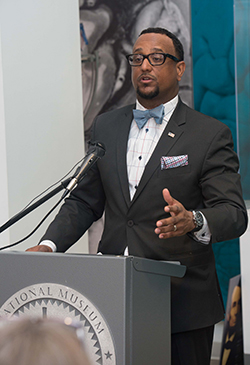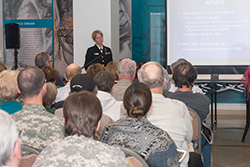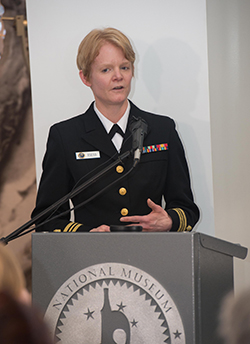Medical examiners conclude Lincoln anniversary commemoration
By Paul Bello, National Museum of Health and Medicine
SILVER SPRING, Md. - Programs commemorating the 150th anniversary of President Abraham Lincoln's assassination concluded April 15 at the National Museum of Health and Medicine (NMHM) in Silver Spring, Maryland. Visitors spanning several generations got a glimpse of 19th century life and learned how Lincoln's death would have ripple effects on a nation steadfast on moving forward.
Roger A. Mitchell Jr., M.D., chief medical examiner, Washington, D.C., hosted a discussion at the exact moment the nation's 16th president took his last breath a century and a half ago. Lincoln was shot the evening of April 14 while attending a play at Ford's Theatre in D.C. He would succumb to his wounds the following morning at 7:22 a.m.
"Just two years before his death, there was the signing of the Emancipation Proclamation in 1863. It was an effort by Lincoln to assure the solvency of the Union," Mitchell told the audience. "Following his death, slavery is still the major economic and social issue at the time, and the majority of black people in this country are attempting to cultivate a new life outside of bondage."
Mitchell discussed the founding of his alma mater, Howard University, which was established on March 2, 1867. Chartered by Congress, the institution would see its medical school open a year later and become the first academic establishment in the U.S. to offer training to aspiring black physicians.
"Howard University has gone on to educate millions of free black men and women, including my family legacy," Mitchell said. "We're all proud graduates of this historic institution which is directly related to the work done by Abraham Lincoln."
He ended his presentation with a quote from Frederick Douglas, adding "Under the wisdom of Abraham Lincoln, we saw ourselves lifted from the depths of slavery to the heights of liberty and manhood."
U.S. Navy Lt. Cmdr. Lisa Rivera, deputy medical examiner, Armed Forces Medical Examiner System, later provided an overview of Lincoln's autopsy, which was performed at the White House under the supervision of doctors associated with the Army Medical Museum (the original name of NMHM).
"The entrance wound observed was in the back of the head and it had smooth, blackened edges. This is a strong indicator that the gunshot was at close range," Rivera said. "Given the amount of time that passed before Lincoln died, I believe it's very possible he could have lived if those treating him had access to the kinds of treatment we now have today. Of course, what kind of life he would have had, we'll never know."
She noted there was a severe blood clot found under the dura (membrane covering the brain) and that Lincoln had sustained significant fractures and bruising above the orbital plates, (the thin bone over his eyes). The bullet that killed him, in addition to skull fragments and locks of his hair removed at autopsy, are on display at NMHM.
For more information, visit www.medicalmuseum.mil

|
Caption:
Roger A. Mitchell, Jr., MD, chief medical examiner, Government of the District of Columbia, speaks at a commemorative ceremony held at the National Museum of Health and Medicine in Silver Spring, Maryland, on April 15, 2015. The ceremony was held to honor the passing of President Abraham Lincoln at that moment 150 years earlier. (Disclosure: This image has been cropped to emphasize the subject.) (National Museum of Health and Medicine photo by Matthew Breitbart / Released) |

|
Caption:
Roger A. Mitchell, Jr., MD, chief medical examiner, Government of the District of Columbia, speaks at a commemorative ceremony held at the National Museum of Health and Medicine in Silver Spring, Maryland, on April 15, 2015. The ceremony was held to honor the passing of President Abraham Lincoln at that moment 150 years earlier. (Disclosure: This image has been cropped to emphasize the subject.) (National Museum of Health and Medicine photo by Matthew Breitbart / Released) |

|
Caption:
U.S. Navy LCDR Lisa Rivera (standing at rear), deputy medical examiner, Armed Forces Medical Examiner System, speaks at the National Museum of Health and Medicine (NMHM) on April 15, 2015. NMHM marked the 150th anniversary of the death of President Abraham Lincoln with a series of special programs in April 2015. Rivera reviewed Lincoln’s autopsy in a special gallery talk held 150 years to the day after the president died. (Disclosure: This image has been cropped to emphasize the subject.) (National Museum of Health and Medicine photo by Matthew Breitbart / Released) |

|
Caption:
U.S. Navy LCDR Lisa Rivera, deputy medical examiner, Armed Forces Medical Examiner System, speaks at the National Museum of Health and Medicine (NMHM) on April 15, 2015. NMHM marked the 150th anniversary of the death of President Abraham Lincoln with a series of special programs in April 2015. Rivera reviewed Lincoln’s autopsy in a special gallery talk held 150 years to the day after the president died. (Disclosure: This image has been cropped to emphasize the subject.) (National Museum of Health and Medicine photo by Matthew Breitbart / Released) |



